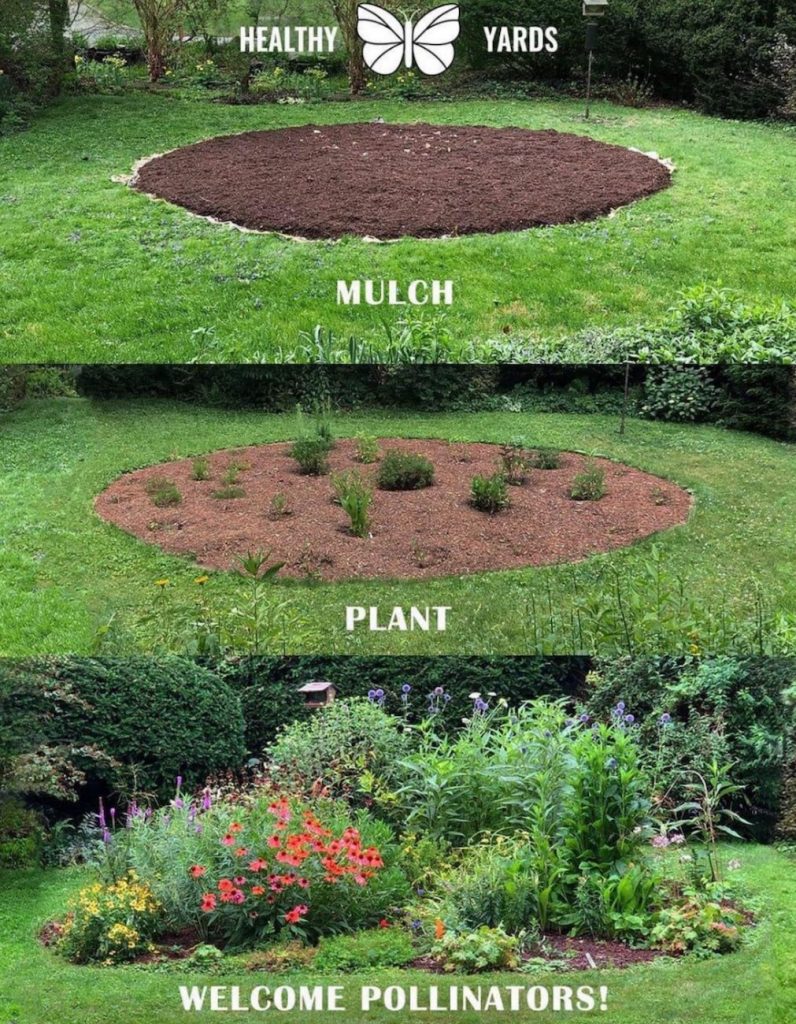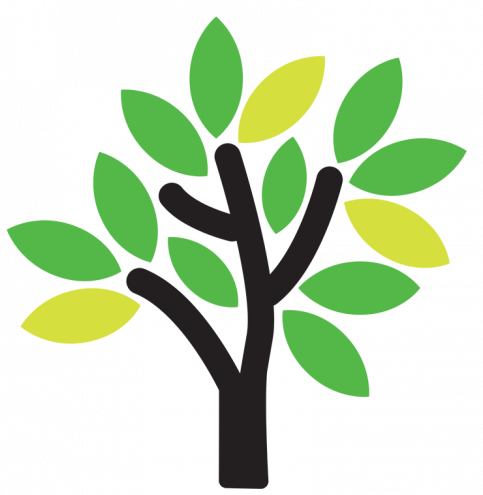What is a native plant and how do I know if a plant is native at a nursery?
A native plant (flower, vine, bush, tree) is a plant that occurs naturally in a region, ecosystem, or habitat, without human introduction. Many of the plants found in residential, business, and commercial landscapes are not native and are a major threat to our ecosystem. Our native birds, pollinators, butterflies, and other organisms have evolved specialized relationships with our native plants and they rely on them for survival. Most plants that people buy from garden nurseries are non-native and did not evolve these specialized relationships with our bees, insects, birds, etc., and therefore negatively impact our ecosystem. Native plants at garden nurseries are usually labeled “native.” If the plant is not labeled as native, you can quickly complete an internet search online. Searching the scientific name (usually italicized) will provide the most reliable results, however, use the common name if there is no scientific name on the label. Figure 1 below is an example of a plant label and how to do an internet search. Search “Asclepias Tuberosa native range.” Search results will provide a description or map of the plant’s native range. But the easiest way to ensure a plant is native is to purchase from a native nursery.
A new bill called the “S-83 Jersey Native Plants Program” will make identifying native plants easier in future years. Plants native to NJ will be labeled. Hopefully, we see this in action soon!

How do I benefit from adding native plants to my garden?
Save time and money: Native plants come back every year. Once you have your garden established, you do not have to spend time and money shopping, planting, and watering. Non-native plants only require a little bit of watering immediately after planting. Once native plants are established, they do not need to be water unless there is an extreme drought. Even then, native plants are very adapted to severe weather such as droughts. If you plant a full garden, native plants will outcompete weeds for resources such as food, sun, and water. You will spend less time weeding the garden and more time enjoying your garden instead.
Wildlife and Aesthetics: It is amazing to see how adding native plants attracts numerous types of butterflies, moths, and birds to your landscape. Adding a variety of native plants with different bloom times can have your garden flowering from early spring to late fall. Native plants can also add color to your landscape throughout the year, including winter, as their leaves, bark, and berries transition with the seasons. Native gardens offer year-round interest. Amazing creatures that might be a rare find in your current garden such as hummingbirds, goldfinches, monarch butterflies, and butterfly checkerspot can become more common sightings. You can choose plants you want to grow in your native garden to attract species you would like to see. While most non-native gardens are devoid of birds in the winter, native gardens provide food that will attract species like the tufted titmouse, dark-eyed juncos, and black-capped chickadees.
Protect Our Farmers and Food Supply: Much of our crop production depends on many types of pollinators and not just honey bees! Supporting a healthy ecosystem supports pollinators, which supports our hard-working farmers that grow the very fruits and vegetables you consume.
Why are native plants important to the environment?
Water conservation: Native plants are adapted to our climate and can survive droughts. Once established you might never have to water your native plants. Since you do not use nearly as much water, if any, you are protecting our water supply for current and future needs that all of us in Hopewell Township depend on.
Wildlife: The consensus from studies in the scientific community is that we are losing insects at an astonishing rate. While estimates vary, studies agree we are losing enough insects to cause catastrophic ecosystem damage. While the exact percentage varies from study to study, the scientific consensus is that we have had a precipitous decline in insects – such as moths, butterflies, and bees – that rely on one or a few native plants for their survival. If we lose our insect species we then lose our native birds as well. For example, a necessity for many of our native bird species is by obtaining thousands of caterpillars per day to feed their young. Caterpillars are very nutrient-dense and are therefore hugely important, if not a necessity, for many bird species. Declining caterpillar species are reducing many of our native bird populations. So, how can you help? Turf grass and non-native species are inhospitable to our native caterpillars. Increasing native plants in our yards, especially under the trees where caterpillars fall, will help recover our native insect and bird populations and can have positive rippling effects across the whole ecosystem.
Where do I get native plants?
“Native Plant Society of New Jersey” and “Jersey-Friendly Yards” and the “Hopewell NJ Native Plant Swap” maintain an up-to-date list of local, nearby nurseries that sell native plants. No matter where you live in New Jersey, you can find a native nursery nearby. Joining the Sourland Conservancy, FoHVOS, or Hopewell NJ Native Plant Swap creates an opportunity to receive or exchange seeds and/or plants. The plants found at most of the “big-box stores” are non-native species. These stores are starting to sell some native plants but they might not always be clearly labeled as “native.” You want to double-check that they are indeed native plants. Either way, use the method described at the beginning of this article to complete an internet search to ensure what you are buying is a native plant.
How do I get started? Can I do this myself?

You can add native plants into an existing garden by mixing in native plants to gardens you currently plant every year. Over time, as the native plants spread, you can plant fewer non-native plants. Another option is to start from scratch and create a small garden like you see below in Figure 2 to practice your native gardening. A corner of the yard is a great way to start practicing native gardening. It is out of the way and is typically unused space. Start with only a few types of plants so you know what to look for the following season when the plants start to germinate in the spring. Once you get more comfortable with native gardening, you can start increasing the number of native plants in your existing garden. You can also consider expanding your gardens to reduce the size of your lawn. Much of our yards are unused spaces. They get mowed and look nice but often serve no functional or environmental purpose. Is there land that is rarely or unused in your yard? You can convert these unused areas to native plants that will provide habitat for our native birds, pollinators, and butterflies.
Are there landscaping companies or local organizations that offer native gardening services?
Complete an internet search for “Jersey Friendly Yards” or “Native Plant Society of New Jersey.” They keep an up-to-date list of local companies on their website that offer plant sales and installation. Hopewell Township also has two organizations that can assist. Friends of Hopewell Valley Open Space (FoHVOS) offers plant sales, consultation, and information for members. The Sourland Conservancy has lots of educational information regarding gardening with native plants including their own YouTube channel with examples of native gardens from members of the Hopewell Township Community.
Won’t deer eat my native plants?
Look for plants labeled as “deer resistant.” Native garden centers label plants that deer typically avoid as “deer resistant.” Native plants that have strong fragrances are typically more deer-resistant than others. Here are a few examples of full-sun plants that deer typically do not eat that could provide you with year round color:
- Blooms in the Spring
- Penstemon digitalis (Foxglove beardtongue)
- Blooms in the Summer
- Pycnanthemum muticum (Short-toothed mountain mint)
- Monarda fistulosa (Wild bergamot) Pictured in feature photo
- Blooms in the Fall
- Solidago altissima (Tall goldenrod)
How do I learn more about native gardening and what plants are native to my area?
- Search “Homegrown National Park” online
- Search “Friends of Hopewell Valley Open Space Residential Community Conservation” (FoHVOS) online
- Search “Sourland Conservancy” online
- Search for “Healthy Yards” on Instagram and Facebook
- Search for “Hopewell, NJ Native Plant Swap” on Facebook. This group consists of experienced and beginners to native gardening. Ask questions and people will help.
- Search for “Native Plant Society of New Jersey” online
- Search for “Jersey Friendly Yards” online
- Search for “Native Plant Finder” online
- Search for “Xerces Society”
- There are many sources online you can utilize
Is this harder than non-native gardening?
No. It is a different type of yard maintenance and there is a learning curve. Follow the recommendations of online resources such as those listed above and join online forums such as the “Hopewell NJ Native Plant Swap” group on Facebook to ask questions. Go to a native nursery and ask the people working there about your gardening project. Native gardeners love to share their knowledge and are passionate about helping others learn as well. Utilizing these resources can save you time and money.
What should I read now that I’m interested in native gardening?
- Nature’s Best Hope by Doug Tallamy
- The Living Landscape by Rick Darke and Doug Tallamy
- Bringing Nature Home by Doug Tallamy
- Native Alternatives to Invasive Plants by C. Colston Burrell
- Native Trees, Shrubs and Vines for Urban and Rural America by Gary Hightshoe
- Plant Local – Do-It-Yourself Native Plant Gardens by Jared Rosenbaum
- “Wildflowers”, “Native, Trees, Shrubs, and Vines”, and “Native Ferns, Moss and Grasses” by William Cullina
- Native Plants of the Northeast: A Guide for Gardening and Conservation by Joseph Leopold
- The Puddle Garden by Jared Rosenbaum (children’s book). Never too early to learn about the benefits of native plants!
To download your own copy of this article and for more articles of interest, go to the Environmental Commission page on the Township’s website- https://www.hopewelltwp.org/540/Current-Environmental-Issues.
Written by Andrew Plunkett, Hopewell Township Environmental Commission




